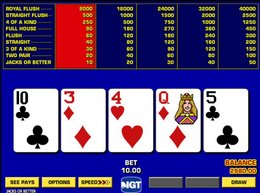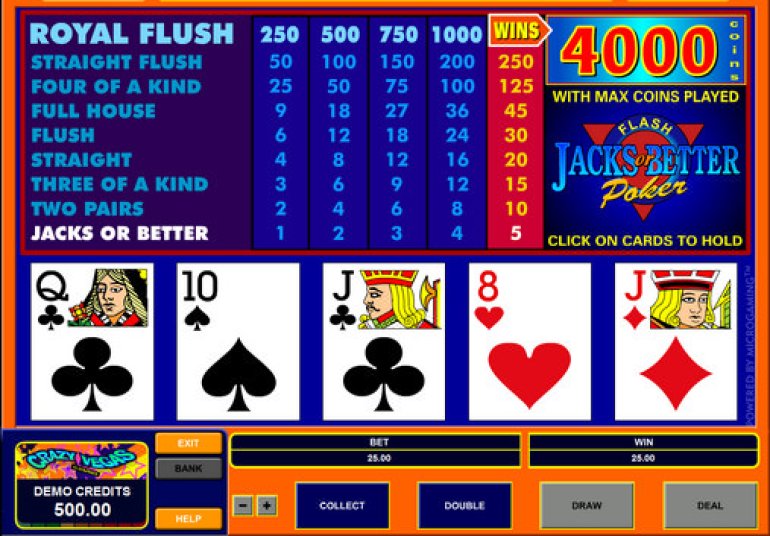6/5 Jacks or Better. Yes, it gets even worse. Some casinos do offer 6/5 Jacks or Better video poker, which only pays out 6 coins for a full house and 5 coins for a flush. The payout percentage for a 6/5 Jacks or Better game is 95%, which means you're giving the casino $5 for every $100 you bet on the machine. That's 10 times the average.
Jacks or Better The most popular version of video poker is Jacks or Better. This is played the same way as five card draw, but players are only awarded money for a pair or Jacks or higher. The typical version of this video poker variety is 9/6 Jacks or Better, which is named after the. Jacks or Better Video Poker strategy tips that will help you increase your win rate and enjoy more this exciting casino game. Did you know that video Poker has the highest payout percentage of all casino games? While the house edge for typical casino games varies between 90 and 97 percent, video Poker can offer up to 99.54 percent. But only if you know what you're doing. Video poker is the umbrella used for dozens of different gambling machines that all feature almost identical game-play. The most basic version of both casino and online video poker today is Jacks or Better, so called because the lowest-paying hand in the game is a pair of jacks, queens, kings, or aces.
The Advanced Side of Jacks or Better Strategy
Strategic online casino games are usually something that appeal to only a certain part of the overall group of players who like to get in on the action. It takes a bit of work and practice to get good at certain titles, and Jacks or Better video poker is definitely one of those.
While you can drastically increase your payout rates by learning the fundamentals of the game, a complete strategy has to include everything else as well.
Here's what we mean by that: Most players want to learn how to play made hands and situations with draws. These spots come up plenty, and they're definitely important to learn. However, learning to play all of the other hands that aren't nearly as fun is important as well. Unfortunately for most players, they tend to skip over these spots and try to 'wing it' instead.
We're going to break down how to play hands where you do not have any made hand or draw at all, and that includes explaining exactly why you need to learn to play these types of hands along with plenty of instructive examples.
Why Learn to Play Such Poor Hands?
There are some statistical realities that are important to understand when it comes to being dealt five-card poker hands.
- Your chances of being dealt three of a kind or better are only about 2.87 percent.
- You have an additional 4.8 percent chance of being dealt two pair.
- One pair hands make up a very substantial 42.3 percent of all starting hands.
Now that makes one pair hands look like they could be the most important hands to learn how to play. However, that would be wrong:
Hands where you only start with a high-card hand, including straight and flush draws, make up more than half of all starting poker hands.
This works out to 50.1 percent of all hands, so it's easy to see how much of the time you're going to run into them.
Advanced Strategic Principles For High-Card Hands
In each hand of Jacks or Better video poker, you have 32 different ways that you can play your discards, and that includes the options to avoid discarding anything at all. In a lot of hands, it's pretty obviously what you should be doing.
With high-card hands, however, it's often much more difficult to decide how to play your hands, and that's what we want to attack here.
Note: In the following, we will not be discussing situations where you have three to a royal flush, four to a straight flush, four to a straight or four to a flush. Those are all basic situations that are outside of the scope of our discussion of advanced strategy.
The Lesser of Two (or Three) Evils
With most high-card hands, there's not a way to play that will be profitable. However, being profitable is not your goal with these hands.
What you actually want to do is to focus on playing the best way that you can to avoid losing as much value as possible.
For example, if you have the hand KQJ64 without any of the high cards matching suits, then playing with KQJ will average a 0.52 payout while playing just QJ averages a payout of 0.50. While this might not seem like much of a difference, it's actually pretty significant.
This represents a difference that's worth about 2 percent of the value of your wager. If you make 50 of these decisions correctly, you'll be up one more bet than you would have been otherwise. Likewise, if you make 50 of these seemingly insignificant decisions incorrectly, then you'll be down a bet that you didn't need to be.
As a result, you often have to think of it as trying to make sure that you take the lesser of two evils. Money you avoid losing is just as good as money you win with a big made hand.
Instructive Hand #1: AhQsJh8d2c
This is a good starting hand to look at because it allows us to establish some key principles of dealing with high-card hands in general. Here is one such principle to consider:
With high-card hands with no major draws, you should first look at the high cards (jack and up) to see which ones you have available and if they are suited.
Situations where you have three to a royal are worth more than four to a flush or four to a straight, so we're going to ignore that scenario for now since we consider it a major draw.
Online casino slot games no download. The question that we have to ask here is that, since we have AhQsJh as our high cards in this scenario, how do we decide which of the three to keep? We can answer this by looking at their average payout values:
- AJ suited pairing – 0.577x
- QJ off-suit pairing – 0.495x
- AQ off-suit pairing – 0.468x
- All three high cards – 0.456x
We see a few general patterns here that will be useful for playing high-card hands in general. First, we see that all of the two-card pairings (no matter the suits) perform significantly better than keeping three high cards. The exception to this would obviously be if those three high cards were of the same suit for a royal draw.
Second, we see that the suited pairing of two cards does best. However, we also see that the pairing of QJ does better than the pairing of AQ when both are off-suit. The reason for this is that both hands can get the same value from pair-based hands, but QJ has the edge over AQ in that it's more likely to make a straight.
From this example and others like it, we can consider the following rules:

- With three high cards that are not all the same suit, play the two that are suited if available.
- If there aren't two of them with suits that match, then play the two lowest-ranked cards of the three.
With those rules having been said, there is are some exceptions to them that we're going to tackle with our next example.
Strategy For Jacks Or Better Video Poker
Instructive Hand #2: AsKsJhTh8h
There's a simple rule here that we're going to introduce that's not something you'll run into a lot but is a fairly advanced concept that will give you some good amounts of added value when you run into it. These are essentially the two key exceptions to the above two rules.
In this situation, according to the rules above, we have three high cards, so we should first check to see what the suits look like. Since the AK pairing is suited, that would normally be the preferred option.
However, when you introduce a ten to the mix, things can get a bit hairy in terms of finding exceptions to the rules.
Consider the following average payouts of various ways to play this hand:
Jacks Or Better Poker Strategy Chart
- JT8, three to a straight flush with one gap – 0.634x
- AK, two suited high cards – 0.574x
- AKJT, four to a Broadway straight – 0.532x
- KJ, lowest two off-suit high cards – 0.477x
- AJ, other two off-suit high cards – 0.465x

- With three high cards that are not all the same suit, play the two that are suited if available.
- If there aren't two of them with suits that match, then play the two lowest-ranked cards of the three.
With those rules having been said, there is are some exceptions to them that we're going to tackle with our next example.
Strategy For Jacks Or Better Video Poker
Instructive Hand #2: AsKsJhTh8h
There's a simple rule here that we're going to introduce that's not something you'll run into a lot but is a fairly advanced concept that will give you some good amounts of added value when you run into it. These are essentially the two key exceptions to the above two rules.
In this situation, according to the rules above, we have three high cards, so we should first check to see what the suits look like. Since the AK pairing is suited, that would normally be the preferred option.
However, when you introduce a ten to the mix, things can get a bit hairy in terms of finding exceptions to the rules.
Consider the following average payouts of various ways to play this hand:
Jacks Or Better Poker Strategy Chart
- JT8, three to a straight flush with one gap – 0.634x
- AK, two suited high cards – 0.574x
- AKJT, four to a Broadway straight – 0.532x
- KJ, lowest two off-suit high cards – 0.477x
- AJ, other two off-suit high cards – 0.465x
So we realize that there is a lot to unpack in this example, so we'll go point by point.
- First, notice that three to a straight flush is better than anything else you can do with three suited high cards except for three to a royal.
- Second, notice that four to a Broadway straight (ie: four cards A-T) is better than two off-suit high cards but worse than two suited high cards.
- Third, see how our previous two rules are reinforced with the relationship between the AK (suited), KJ (off-suit) and AJ (off-suit) pairings and their relative values.
The idea with how we're introducing these examples hands is as follows: We want you to start with the basic way to play hands with three high cards, and then we want you to see that there are two exceptions to those rules, both of which are shown in the second instructive hand.
With that out of the way, we'll head into spots with just two high cards, which are actually much easier.
Instructive Hand #3: KsJh9s8h3d
As always, the first thing you'll do is look to see what the high cards are and what their suits are like. It'll also be notable if you have a ten because, as we mentioned earlier, having a ten available is generally a sign that there are some potential exceptions to the general rules. There's no ten here, so it's no problem for this hand.
With two high cards and no available draws, you'll virtually always play with those two high cards whether they are suited or not.
To show what we mean, consider the following scores for the various ways to play this hand:
- KJ pairing – 0.490x
- J alone – 0.463x
- K alone – 0.457x
As you can see, there aren't really any other ways to play the hand, and that helps to make spots with two high cards really easy and intuitive. There aren't isn't much in terms of exceptions to the rule that we haven't already covered above with three to a straight flush (even with a gap) being better than two off-suit high cards.
Instructive Hand #4: KcTc8s5s2h
When you have just one high card available, and there aren't any draws, you'll virtually always play with a draw just to that one high card. However, if you've been paying attention to the process we've been showing here, after looking at your high cards, you should look to see if there is a ten.
With just one high card, looking for the ten is really important because it can indicate a relatively common exception to the rule.
If we look at the payouts for playing this hand with various discard combinations, you'll see the exception right away:
- KT suited – 0.479x
- K alone – 0.464x
- Discard All – 0.342x
The exception to the rule is this: With KT suited, QT suited or JT suited, those pairings are better than the K, Q or J by themselves, respectively.
It's important to note that this does not work with the AT suited pairing, and it does not work with off-suit combinations of KT/QT/JT. https://friendly-download.mystrikingly.com/blog/free-yo-yos.
Putting It All Together
To tie all of this together, there's a process to follow that can walk you through all of this once you understand the underlying mathematics we have dove into above of why the different types of hands are worth what they are relative to each other.
Initially, you need to look at how many high cards there are, what their suits are and if there are any tens available.
Once you have that information in mind, it's actually pretty straightforward to figure out how you should be thinking about playing the hand (if you have only one high card, than you should play it, for example, unless you have a suited ten to go with it). Wolf landing page designer 1 36 14.
What makes these hands actually play in such a tricky way is that the exceptions to the rules are not intuitive at all, and they can be difficult to learn and remember.
This is why we have worked through a set of example hands so that you can see how they work in the practical application of this information. This will better help you to put it at work when you're at the games, which is when all of this knowledge really counts.
Overview
Jacks or Better video poker, despite being one of the most basic and fundamental games in the genre, is a very strategically deep title. It requires a very solid core of basic knowledge to perform well at all, but you can also do a deep-dive into advanced strategy like what we have done here to give yourself a bit of a boost beyond what you would otherwise be able to get.
It's these advanced strategies that determine who is really the best video poker player since it's the type of material we have covered above that so many players blow off because they don't think that playing 'junk hands' is all that important. They are mistaken, and that is how you can outperform them.
